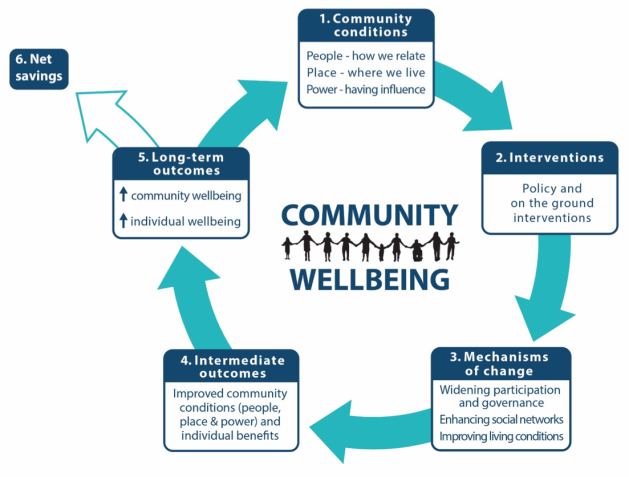As well as this week’s blog, check out our latest call for evidence on joint-decision making in communities.

Jane South is a member of the Centre’s community wellbeing team and professor of healthy communities working in the field of volunteering, active citizenship and community health. In this blog she shares the thinking behind the new theory of change model the team has created after carrying out research, workshops and public dialogues.
Personal experience tells us that the communities we’d like to live in are positive, safe and sociable. And, of course, research shows how much community life and good social connections matter for our health and wellbeing.
As part of the Centre, our communities evidence programme is reviewing and summarising existing evidence for what works to make communities more positive places for people to live in. To help us do this, we’ve developed a ‘theory of change’. This describes the ways change can happen to improve community wellbeing.
There has been increasing interest in the UK in using a theory of change approach to help unpack how programmes work, which in turn makes it easier for evaluations to ‘test’ the pathways to outcomes. Our theory of change describes a cyclical process of six stages with the ultimate aim of improving community and individual wellbeing. It’s our first attempt and draws heavily on what we heard from people and community organisations across the country during the engagement phase at the start of the project. You can see the results of that engagement in our Voice of the User work.

How the process for change works
The starting point for change is community conditions (box one in the diagram). The places where we live, how we relate to others and whether we have a say in how our local area run all influence our wellbeing. But while some people are part of communities that help them flourish, others are not.
There are things that government, organisations and individuals can all do to improve community wellbeing. For the purposes of this theory of change we’ve called these interventions(box two), but this doesn’t mean they have to be initiatives ‘done to’ communities – they could be things that people organise themselves in their neighbourhood.
Mechanisms of Change (box three) are then created, such as improving living environments, strengthening social connections and making it easier for people to take part. Things begin to change at a local level and these improved community conditions then give us the best chances to live, work and play well (box four) . Eventually changes can lead to long-term wellbeing outcomes (box five) for communities and individuals, and the ultimate reason for making change happen.
Where this community wellbeing cycle works well, there are feedback loops and things keep improving as people are more connected and involved in community life and feel the benefits. Potentially there could be net savings from improvements in community wellbeing, although this is not a necessary part of the change process. And obviously, improving community wellbeing requires investment over time.
How can you use the theory of change?
We hope that this theory of change provides a framework for understanding and improving community wellbeing. It will also be used to help us interpret evidence. Communities are of course diverse and what works in one community may work differently- or not at all – elsewhere. This theory of change could be used and adapted in local projects as a planning and evaluation aid. Key questions include: What is the relationship between wellbeing benefits for the individual and for the whole community? How do we measure more of what matters, such as changes in social relationships, safety, trust and belonging?
What happens next?
Over the course of this project, we will be reviewing the community wellbeing evidence for interventions related to housing, social relations and co-production. As we find answers about what works we will refine and update our theory of change, backing it up with the evidence.
But a lot of the evidence doesn’t exist in academic journals, it lies with people working on the ground. We welcome comments on this initial theory of change – does it fit into the way you already think about improving wellbeing in your area? Do you have ideas of how it could be used? Are there things that are missing, or don’t make sense for you? We’d love to hear from you, either in the comments below, on our forum, on Twitter, or via email at info@whatworkswellbeing.org.
No comments:
Post a Comment